Charles M. Kozierok The TCP-IP Guide
Подождите немного. Документ загружается.


The TCP/IP Guide - Version 3.0 (Contents) ` 741 _ © 2001-2005 Charles M. Kozierok. All Rights Reserved.
In this example, Router A and Router D are internal routers. Router B and Router C are
area border routers, and comprise the backbone (Area 0) of the internetwork. Routers A, B
and C will maintain an LSDB describing Area 1, while Routers B, C and D will maintain an
LSDB describing Area 2. Routers B and C maintain a separate LSDB for the backbone.
There is no backbone router other than the area border routers B and C. However, suppose
we had a router E that had only direct connections to RB and RC. This would be a
backbone router only.
You have probably already discovered the chief drawback to hierarchical topology:
complexity. For large autonomous systems, however, it has significant advantages over
making every router a peer. At the same time, the conceptual complexity is made worse by
the need for very careful design, especially of the backbone. If the hierarchy is not set up
properly, a single failure of a link between routers could disrupt the backbone and isolate
one or more of the areas (including all the devices on all networks within the area!)
OSPF Route Determination Using SPF Trees
The key data structure maintained by each router in an OSPF autonomous system (AS) is
the link-state database (LSDB). The LSDB contains a representation of the topology of
either the entire AS (in basic topology) or a single area (in hierarchical topology). As we
have seen earlier in this section, each router in the AS or area has the same LSDB, so it
represents a neutral view of the connections between routers and networks.
Of course, each router needs to participate in keeping the LSDB up to date, but it also has
its own “selfish” concerns. It needs to be able to determine what routes it should use for
datagrams it receives from its connected networks—this is, after all, the entire point of a
routing protocol.
The SPF Tree
To find the best route from any router, it must determine the shortest path between itself and
each router or network in the AS or area. For this, it needs not a neutral view of the inter-
network but a view of it from its own perspective.
The router creates this perspective by taking the information in the LSDB and transforming
it into a shortest path first tree or SPF tree. The term “tree” refers to a data structure with a
root that has branches coming out that go to other nodes, which in turn have branches. The
structure as a whole looks like an upside-down tree. In this case, the SPF tree shows the
topology information of the AS or area with the router constructing the tree at the top. Each
directly-connected router or network is one step down in the tree; each router or network
connected to these first-level routers or networks is then connected, and so on, until the
entire AS or area has been represented.
Again, the router doesn't really make the tree; it is just an algorithmic calculation performed
by the computer within the router. Once this is done, however, this logical construct can be
used to calculate the cost for that router to reach any router or network in the AS (or area).
In some cases, there may be more than one way to reach a router or network, so the tree is
constructed to show only the shortest (lowest-cost) path to the network.
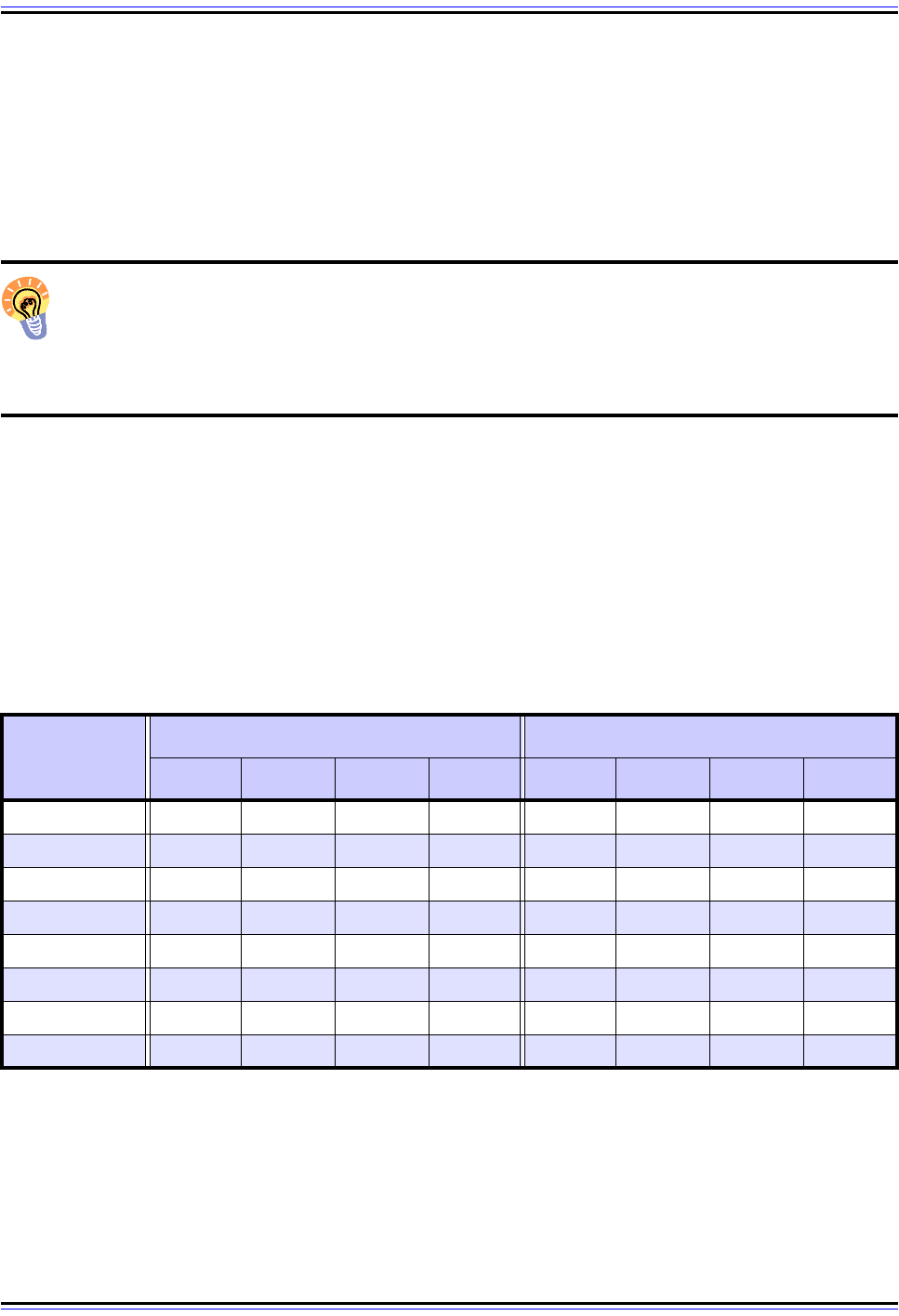
The TCP/IP Guide - Version 3.0 (Contents) ` 742 _ © 2001-2005 Charles M. Kozierok. All Rights Reserved.
Of course, each router is only responsible for sending a datagram on the next leg of its
journey, and not for what happens to the journey as a whole. After the SPF tree is done, the
router will create a routing table with an entry for each network, showing the cost to reach it,
and also the next hop router to use to reach it.
The SPF tree is created dynamically based on the current state of the LSDB. If the LSDB
ever changes, the SPF tree and the routing information are recalculated.
Key Concept: To determine what routes it should use to reach networks in its auton-
omous system, a router generates a shortest path first tree (SPF tree) from its link-
state database. This tree contains the same basic information as the LSDB but
presents it from the point of view of the router doing the calculation so that router can see
the costs of various paths to different networks.
OSPF Route Determination Example
I can almost see your eyes glazing over, so let's go back again to the example we have
been using in this section. I am going to assume we are looking at the whole AS as a whole
in basic topology, for simplicity. In Table 125, I have repeated the LSDB for this AS, and I
have taken the liberty of replacing the “☯“s with cost metrics; these are shown in Figure 181
as well. Again, remember there is no cost to reach a router from a network, so those links
have a non-zero cost only going from the router to the network.
Now, let's construct the SPF tree for RC. We can do this in iterations, as follows (this is
shown graphically in Figure 182 as well for your convenience):
First Level
To construct the first level of the tree, we look for all devices that RC can reach directly. We
find:
Table 125: Example OSPF Link State Database (LSDB) With Costs
To Router /
Network
From Router From Network
RA RB RC RD N1 N2 N3 N4
RA 00
RB 5 0 0
RC 500
RD 0 0
N1 2
N2 3 4 3
N3 561
N4 4
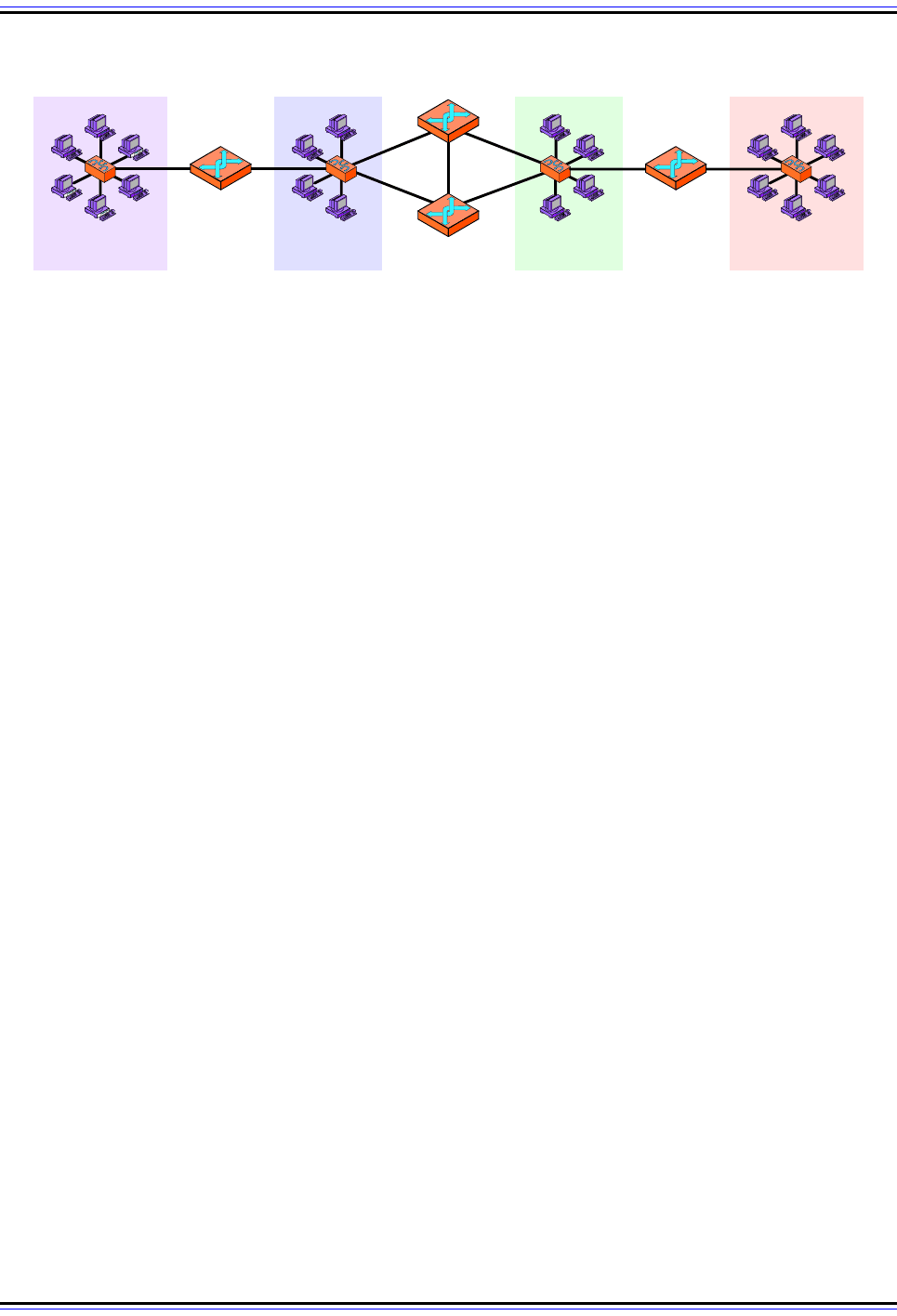
The TCP/IP Guide - Version 3.0 (Contents) ` 743 _ © 2001-2005 Charles M. Kozierok. All Rights Reserved.
☯ RB, with a cost of 5.
☯ N2, with a cost of 3.
☯ N3, with a cost of 6.
Second Level
To construct the second level, we look for all devices that the devices on the first level can
reach directly. We then add the cost to reach each device on the first level to the cost of
each device at the second level:
☯ RB: RB has a cost of 5 and can reach:
☯ RC, with a cost of 5, total cost of 10.
☯ N2, with a cost of 4, total cost of 9.
☯ N3, with a cost of 5, total cost of 10.
☯ N2: N2 has a cost of 3 and can reach:
☯ RA, with a cost of 0, total cost of 3.
☯ RB, with a cost of 0, total cost of 3.
☯ RC, with a cost of 0, total cost of 3.
☯ N3: N3 has a cost of 6 and can reach:
☯ RB, with a cost of 0, total cost of 6.
☯ RC, with a cost of 0, total cost of 6.
☯ RD, with a cost of 0, total cost of 6.
You probably can see immediately that we ended up with a number of different paths to the
same devices or networks, some of which make no sense. For example, we don't really
care about any path that goes to RC, since we are RC! Similarly, we can weed out certain
paths immediately because we already have a shorter path to them; taking a path through
RB to N3 with a cost of 10 makes no sense when we can go directly at the first level for a
cost of 6. So, after separating out the chaff, we end up with the following “wheat” at the
second level:
Figure 181: Example OSPF Autonomous System With Costs
This is the same sample AS that is shown in Figure 179, but with costs assigned to each of the links between
routers and networks. Costs between routers and networks are applied only in the direction from the router to
the network.
Network 1
RA
Network 2 Network 3 Network 4
RB
RC
RD
5
23
45
36
14
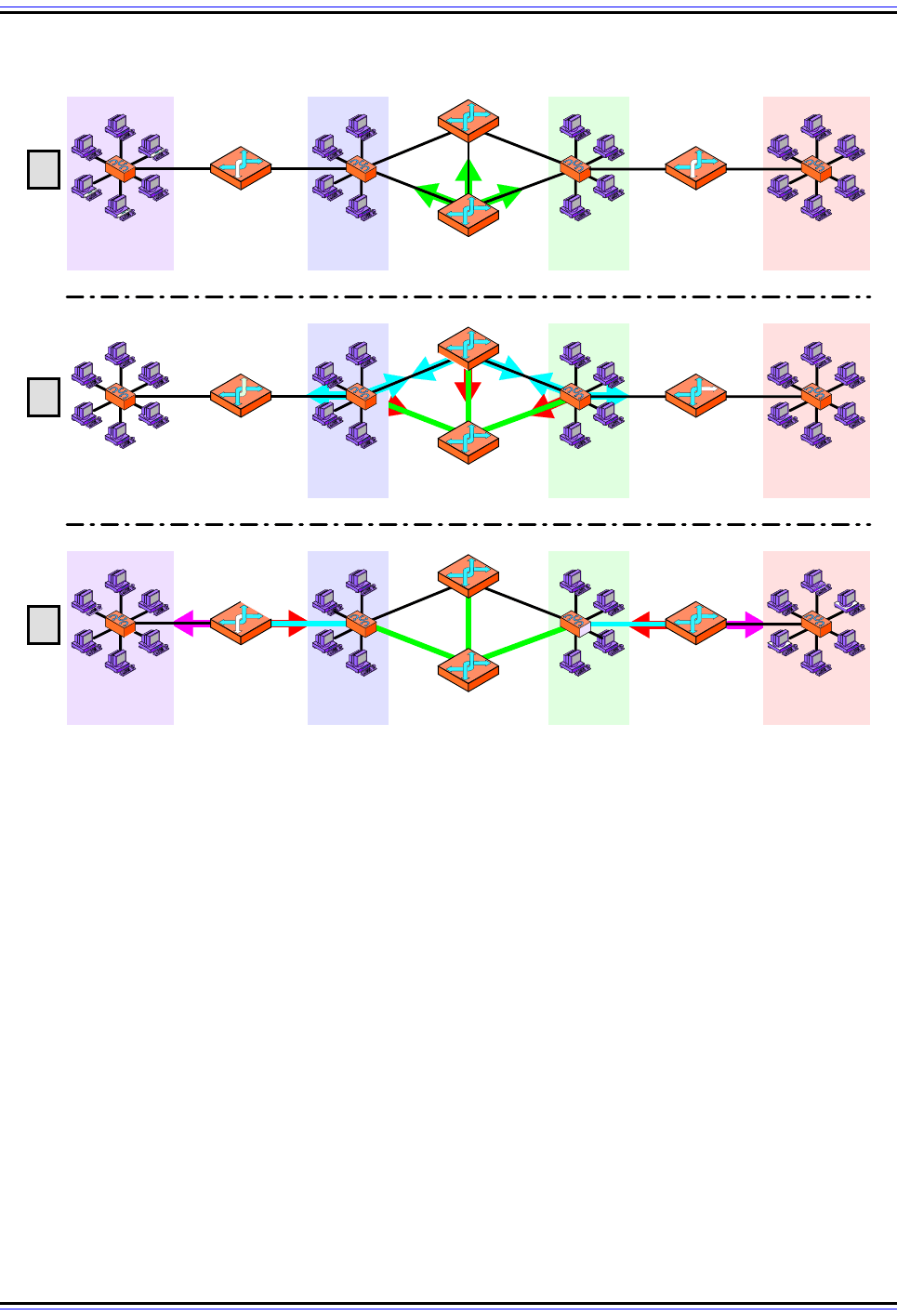
The TCP/IP Guide - Version 3.0 (Contents) ` 744 _ © 2001-2005 Charles M. Kozierok. All Rights Reserved.
☯ N2 to RA, with a cost of 3.
☯ N3 to RD, with a cost of 6.
Third Level
We continue the process by looking for devices that connect to the “weeded-out” devices
we found on the second level (this time I am only showing the meaningful ones):
☯ RA: RA connects to N1, with a cost of 2, total cost of 5.
☯ RD: RD connects to N4, with a cost of 4, total cost of 10.
Figure 182: OSPF Route Determination Using The Shortest Path First Algorithm
This diagram shows graphically how a router, in this case RC, determines the best path to various networks.
The arrows here represent not the transfer of data but rather the examination of various links from a router to
other routers or networks. In panel #1, RC examines its LSDB and determines the cost for each of its directly-
linked devices. In #2, the second level of the SPF tree is constructed by adding to those numbers the costs of
all routers/networks that connect to the routers/networks found in panel #1. (The red arrows represent “looking
back” in the direction we came from in the prior step, which we don’t pursue.) In #3 the process continues,
resulting in the determination of a cost of 5 for RC to reach N1 and 10 to reach N4.
RB
#1
RB
#2
N1
RA
N2 N3 N4
RB
RC
RD
#3
3+0
6+0+4
3+0+2
6+0
3
5
6
N1
RA
N2 N3 N4RC
RD
5
36
3
5
N1
RA
N2 N3 N4RC
RD
5+4
6
5+5
3+0
3+0
6+0
6+0
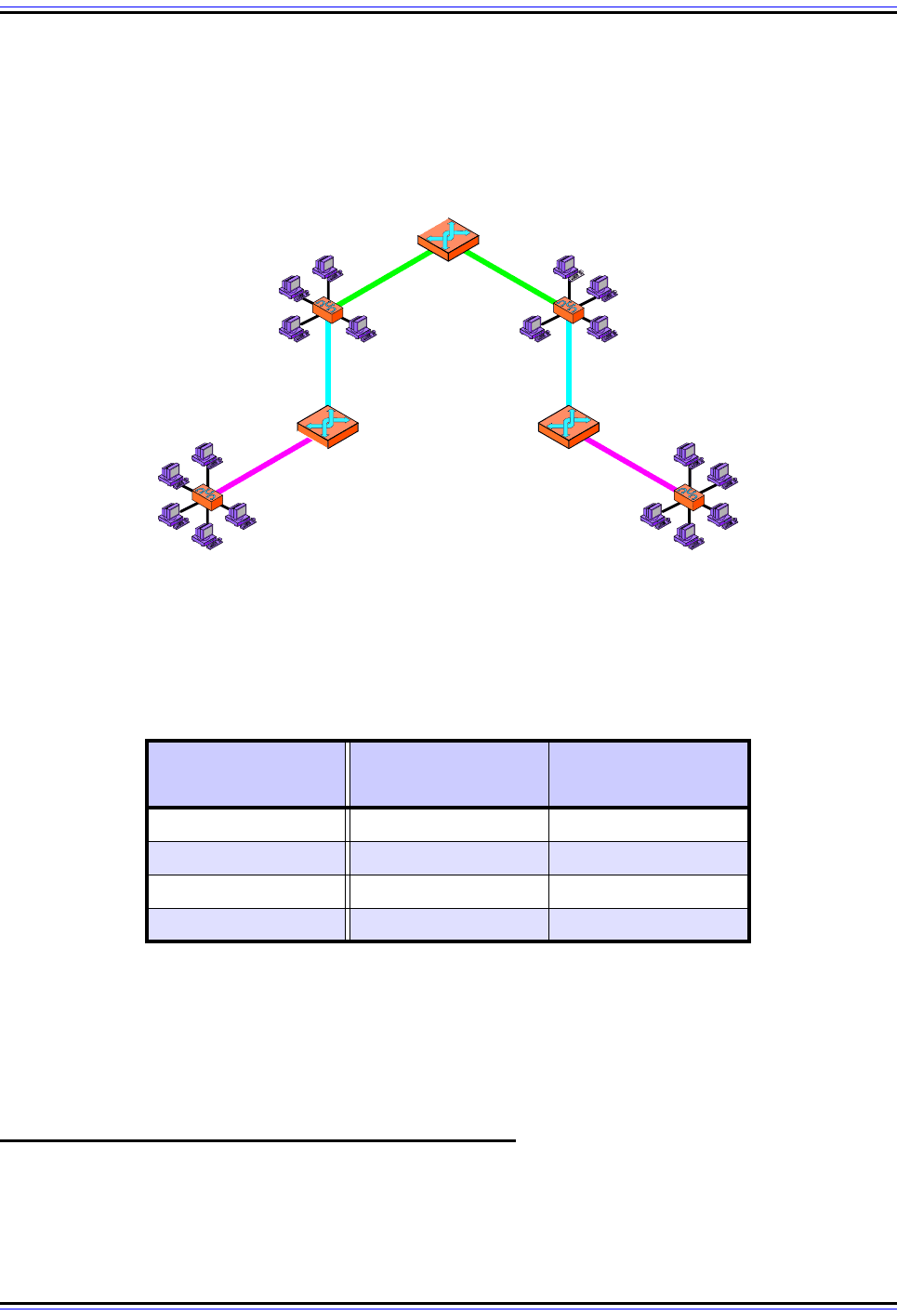
The TCP/IP Guide - Version 3.0 (Contents) ` 745 _ © 2001-2005 Charles M. Kozierok. All Rights Reserved.
Shortest Path Tree and Route Calculation Results
In this simple example, we only need three levels to construct the tree for RC (we would
need more for RA or RD, however.) The final results would be the tree in Figure 183, and
the routing information for RC to the four networks that is shown in Table 126.
This of course is what you would expect in this very simple example. Note that there are no
specific entries for other routers, since they are the “means to the end” of reaching
networks. However, if one of the other routers were a boundary router that connected the
AS to the outside world, there would be entries for the networks to which the boundary
router connected, so RC knew to send traffic for those networks to that boundary router.
OSPF General Operation and Message Types
As a routing protocol, the main job of OSPF is to facilitate the exchange of routing infor-
mation between routers. Each router in an OSPF autonomous system that runs OSPF
software that is responsible for various tasks, such as setting timers to control certain activ-
ities that must occur on a regular basis, and the maintenance of important data structures,
Figure 183: OSPF Calculated Shortest Path First Tree
This is a graphical representation of the SPF tree calculated in Figure 182, showing only the final results of the
calculation process.
Table 126: Example Calculated OSPF Routes
Destination
Network
Cost Next Hop
N1 5RA
N2 3 (local)
N3 6 (local)
N4 10 RD
RC
RA RD
N2 N3
N1 N4
36
3+0+2 6+0+4

The TCP/IP Guide - Version 3.0 (Contents) ` 746 _ © 2001-2005 Charles M. Kozierok. All Rights Reserved.
such as the link-state database (LSDB). Most importantly, each OSPF router must both
generate and respond to OSPF messages. It is this messaging system that allows
important routing information to be shared within an AS or area, which makes it crucial to
understanding how OSPF works. So, it's worth taking a look at the message types and how
they are used.
OSPF Message Types
Unlike RIP, OSPF does not send its information using the User Datagram Protocol (UDP).
Instead, OSPF forms IP datagrams directly, packaging them using protocol number 89 for
the IP Protocol field. OSPF defines five different message types, for various types of
communication:
1. Hello: As the name suggests, these messages are used as a form of greeting, to allow
a router to discover other adjacent routers on its local links and networks. The
messages establish relationships between neighboring devices (called adjacencies)
and communicate key parameters about how OSPF is to be used in the autonomous
system or area.
2. Database Description: These messages contain descriptions of the topology of the
AS or area. That is, they convey the contents of the link-state database for the auton-
omous system or area from one router to another. Communicating a large LSDB may
require several messages to be sent; this is done by having the sending device desig-
nated as a master device and sending messages in sequence, with the slave
(recipient of the LSDB information) responding with acknowledgements.
3. Link State Request: These messages are used by one router to request updated
information about a portion of the LSDB from another router. The message specifies
exactly which link(s) about which the requesting device wants more current
information.
4. Link State Update: These messages contain updated information about the state of
certain links on the LSDB. They are sent in response to a Link State Request
message, and also broadcast or multicast by routers on a regular basis. Their contents
are used to update the information in the LSDBs of routers that receive them.
5. Link State Acknowledgment: These messages provide reliability to the link-state
exchange process, by explicitly acknowledging receipt of a Link State Update
message.
OSPF Messaging and General Operation
The use of these messages is approximately as follows. When a router first starts up it will
send a Hello message out to see if any neighboring routers are around running OSPF, and
it will also send them out periodically to discover any new neighbors that may show up.
When an adjacency is set up with a new router, Database Description messages will then
be sent to initialize the router's LSDB.
Routers that have been initialized enter a steady state mode. They will each routinely
“flood” their local networks with Link State Update messages, advertising the state of their
links. They will also send out updates when they detect a change in topology that needs to

The TCP/IP Guide - Version 3.0 (Contents) ` 747 _ © 2001-2005 Charles M. Kozierok. All Rights Reserved.
be communicated. They will of course receive Link State Update messages sent by other
devices, and respond with Link State Acknowledgments accordingly. Routers may also
request updates using Link State Request messages.
Key Concept: The operation of OSPF involves five message types. Hello messages
are used to establish contact between routers, and Database Description messages
to initialize a router’s link-state database. Routine LSDB updates are sent using Link
State Update messages, which are acknowledged using Link State Acknowledgments. A
device may also request a specific update using a Link State Request.
When hierarchical topology is used, internal routers maintain a single LSDB and perform
messaging only within an area. Area border routers have multiple LSDBs and perform
messaging in more than one area. They, along with any other OSPF backbone routers, also
exchange messaging information on the backbone, including summarized link-state infor-
mation for the areas they border.
Again, all of this is highly simplified; the OSPF standard contains pages and pages of
detailed rules and procedures governing the exact timing for sending and receiving
messages.
OSPF Message Authentication
The OSPF standard specifies that all OSPF messages are authenticated for security. This
is a bit misleading, however, since one of the authentication “methods” supported is “null
authentication”—meaning no authentication is used. More security is provided by using the
optional simple password authentication method, and the most security through the use of
cryptographic authentication. These methods are described in Appendix D of RFC 2328.
Note: The Hello messages used in OSPF are also sometimes called the Hello
Protocol. This is especially poor terminology because there is an actual routing
protocol, described in the next section, called the HELLO Protocol. The two
protocols are not related. However, I suspect that the OSPF Hello messages may have
been so named because they serve a similar purpose to the messages used in the
independent HELLO protocol.
OSPF Message Formats
OSPF uses five different types of messages to communicate both link-state and general
information between routers within an autonomous system or area. To help illustrate better
how the OSPF messages are used, it's worth taking a quick look at the format used for
each of these messages. Well, I guess I am being somewhat liberal in my use of the term
“quick” here. ☺

The TCP/IP Guide - Version 3.0 (Contents) ` 748 _ © 2001-2005 Charles M. Kozierok. All Rights Reserved.
OSPF Common Header Format
Naturally, each type of OSPF message includes a slightly different set of information—
otherwise, they wouldn't be different message types! However, they all share a similar
message structure, beginning with a shared 24-byte header. This common header allows
certain standard information to be conveyed in a consistent manner, such as the number of
the version of OSPF that generated the message. It also allows a device receiving an
OSPF message to quickly determine which type of message it has received, so it knows
whether or not it needs to bother examining the rest of the message.Table 127 and Figure
184 show the common OSPF header format.
Table 127: OSPF Common Header Format
Field Name
Size
(bytes)
Description
Version # 1 Version Number: Set to 2 for OSPF version 2.
Type 1
Packet Length 2
Packet Length: The length of the message, in bytes, including the 24
bytes of this header.
Router ID 4
Router ID: The ID of the router that generated this message (generally its
IP address on the interface over which the message was sent).
Area ID 4
Area ID: An identification of the OSPF area to which this message
belongs, when areas are used.
Checksum 2
Checksum: A 16-bit checksum computed in a manner similar to a
standard IP checksum. The entire message is included in the calculation
except the Authentication field.
AuType 2
Authentication 8
Authentication: A 64-bit field used for authentication of the message, as
needed.
Type: Indicates the type of OSPF message:
Type Value OSPF Message Type
1 Hello
2 Database Description
3 Link State Request
4 Link State Update
5 Link State Acknowledgment
A
u
th
en
ti
ca
ti
on
T
ype:
I
n
di
ca
t
es
th
e
t
ype o
f
au
th
en
ti
ca
ti
on use
d
f
or
thi
s
message:
Authentication Type
Value
OSPF Authentication Type
0 No Authentication
1 Simple Password Authentication
2 Cryptographic Authentication
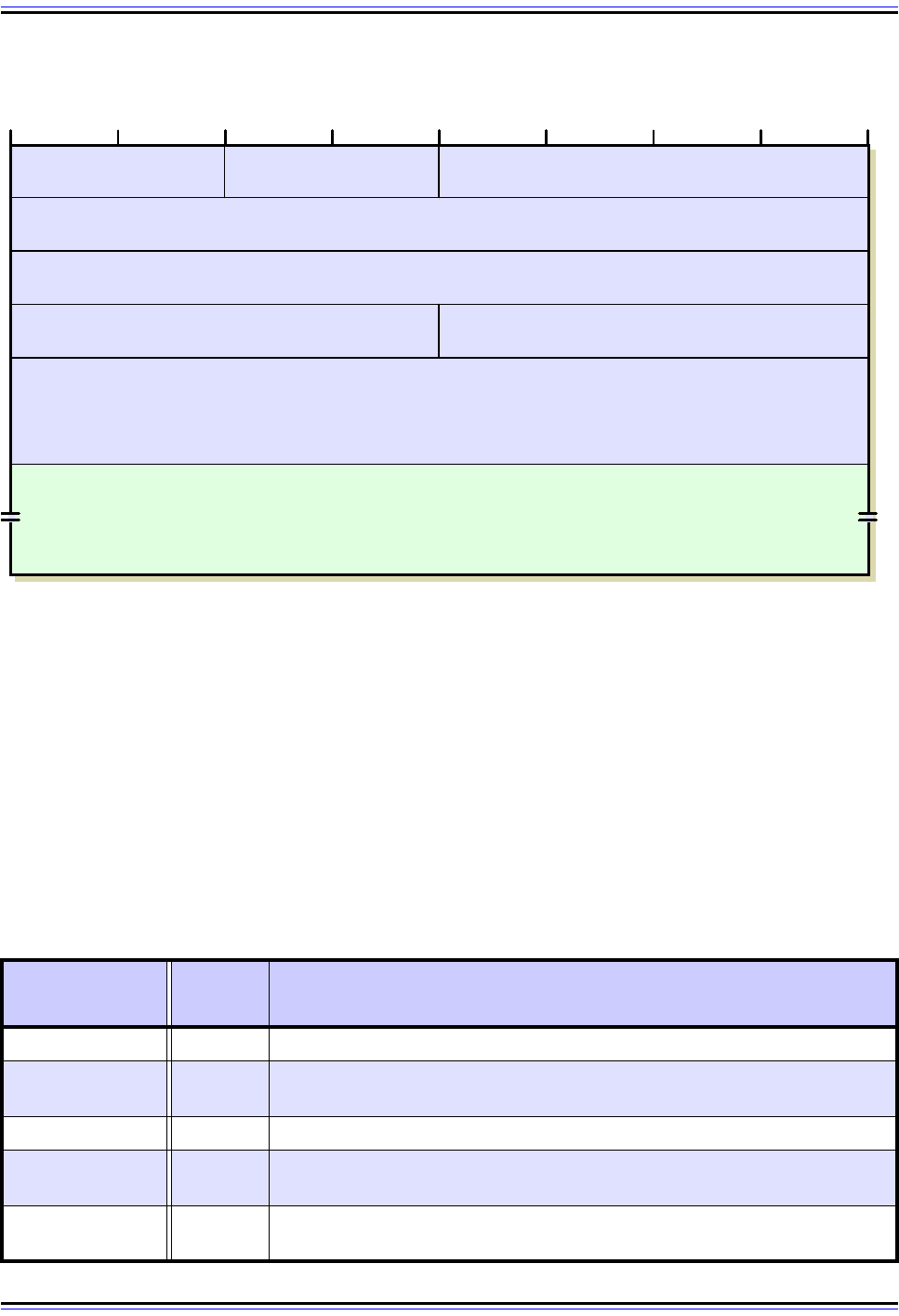
The TCP/IP Guide - Version 3.0 (Contents) ` 749 _ © 2001-2005 Charles M. Kozierok. All Rights Reserved.
Specific Message Formats
Following this header, the body of the message includes a variable number of fields is
included that depends on the message type. Each of the message formats is described in
detail in RFC 2328; since some are quite long I will describe their fields only briefly here.
Hello Message Format
These messages have a Type value of 1 in the header, and the field structure shown in
Table 128 and Figure 185 in the body of the message.
Figure 184: OSPF Common Header Format
Table 128: OSPF Hello Message Format (Page 1 of 2)
Field Name
Size
(bytes)
Description
Network Mask 4 Network Mask: The subnet mask of the network the router is sending to.
Hello Interval 2
Hello Interval: The number of seconds this router waits between sending
Hello messages.
Options 1 Options: Indicates which optional OSPF capabilities the router supports.
Rtr Pri 1
Router Priority: Indicates the router's priority, when electing a backup
designated router.
Router Dead
Interval
4
Router Dead Interval: The number of seconds a router can be “silent”
before it is considered to have failed.
Version Number = 2 Type Packet Length
Router ID
Area ID
Checksum Authentication Type
Authentication
Message Body
4 8 12 16 20 24 28 320
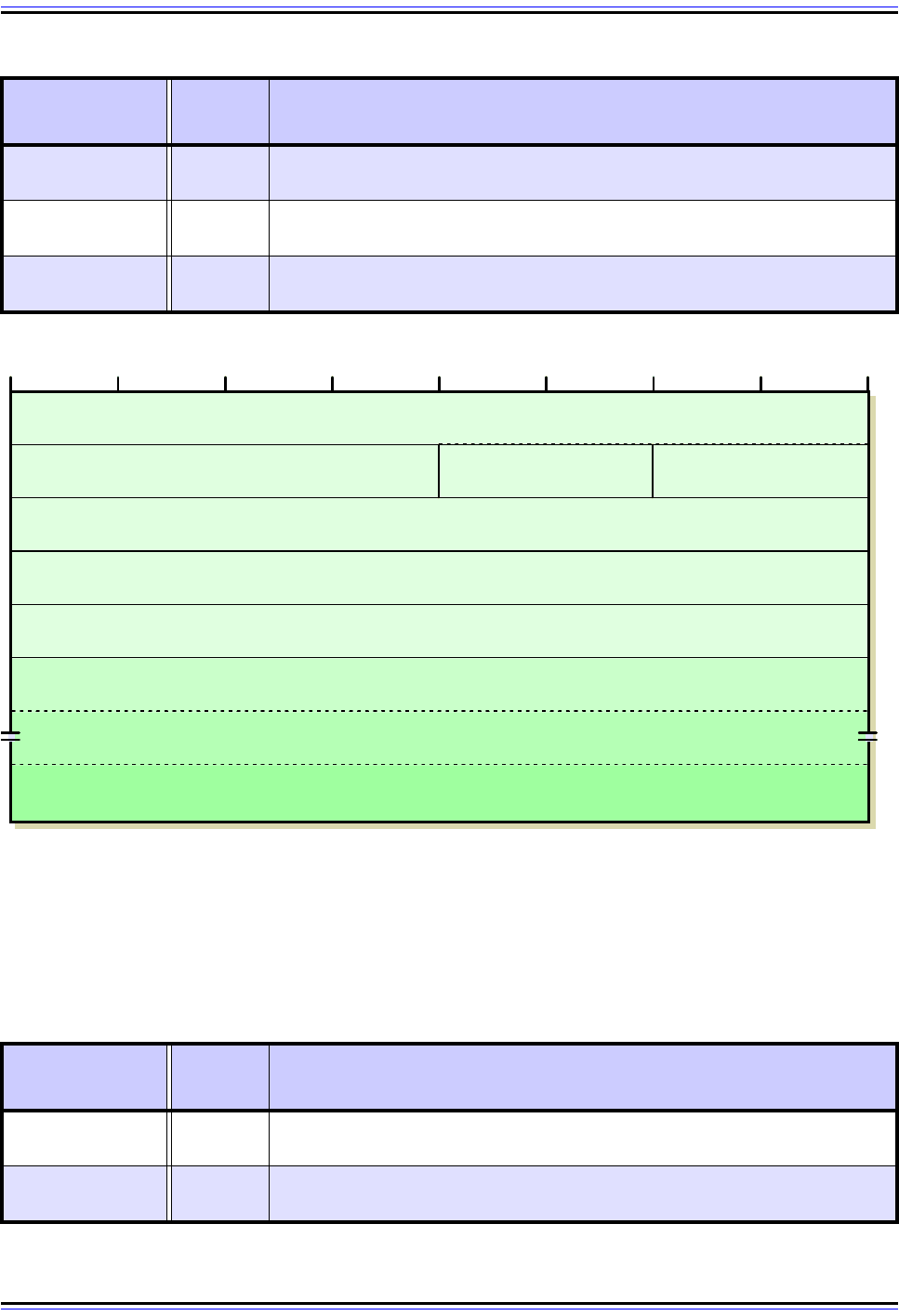
The TCP/IP Guide - Version 3.0 (Contents) ` 750 _ © 2001-2005 Charles M. Kozierok. All Rights Reserved.
Database Description Message Format
These messages have a Type value of 2 in the header, and the body structure depicted in
Table 129 and Figure 186.
Designated
Router
4
Designated Router: The address of a router designated for certain special
functions on some networks. Set to zeroes if there is no designated router.
Backup Desig-
nated Router
4
Backup Designated Router: The address of a backup designated router.
Set to all zeroes if there is no backup designated router.
Neighbors
Multiple
of 4
Neighbors: The addresses of each router from which this router has
received Hello messages recently.
Figure 185: OSPF Hello Message Format
Table 129: OSPF Database Description Message Format (Page 1 of 2)
Field Name
Size
(bytes)
Description
Interface MTU 2
Interface MTU: The size of the largest IP message that can be sent on this
router's interface without fragmentation.
Options 1
Options: Indicates which of several optional OSPF capabilities the router
supports.
Table 128: OSPF Hello Message Format (Page 2 of 2)
Field Name
Size
(bytes)
Description
Network Mask
Hello Interval Options Router Priority
Router Dead Interval
Designated Router
Backup Designated Router
Neighbor #1
Neighbor #N
4 8 12 16 20 24 28 320
...
